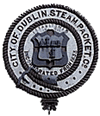 |
 |
 |
||||||
The Sinking A pre-war picture of RMS Leinster at anchor in Kingstown Harbour. Departure:Shortly before 9 a.m. on 10 October 1918 the RMS Leinster left
Carlisle Pier, Kingstown (now Dun Laoghaire), Co. Dublin, Ireland. Bound
for Holyhead Anglesey, Wales she carried 813 passengers and crew. The
ship was commanded by Captain William Birch (61), a Dubliner who had settled
with his family in Holyhead. Apart from Birch, the Leinster had
a crew of 78, drawn from the ports of Kingstown (Dun Laoghaire) and Holyhead.
Also on board were 22 postal sorters from Dublin Post Office, working
in the ship's onboard postal sorting room. There were 201 civilian passengers,
men, women and children, most of them from Ireland and Britain. But by far the greatest number of passengers on board the Leinster were military personnel. Many of them were going on leave or returning from leave. They came from Ireland, Britain, Canada, the United States, New Zealand and Australia. On the Western Front the German Army was being pushed back by the relentless assaults of the Allied armies. On 4 October Germany had asked U.S. President Woodrow Wilson for peace terms. As the Leinster set sail the weather was fine, but the sea was rough following recent storms. Earlier that morning a number of Royal Navy ships at sea off Holyhead were forced to return to port due to the stormy conditions. Torpedoed!
Shortly before 10 a.m. about 16 miles from Kingstown (Dun Laoghaire) a few people on the deck of the Leinster saw a torpedo approaching the port (left) side of the ship. It missed the Leinster, passing in front of her. Soon afterwards another torpedo struck the port side where the postal sorting room was located. Postal Sorter John Higgins said that the torpedo exploded, blowing a hole in the port side. The explosion traveled across the ship, also blowing a whole in the starboard side. In an attempt to return to port, the Leinster turned 180 degrees, until it faced the direction from which it had come. With speed reduced and slowly sinking, the ship had sustained few casualties. Lifeboats were being launched. At this point a torpedo struck the ship on the starboard (right) side, practically blowing it to pieces. The Leinster sank soon afterwards, bow first. The cruel sea:
Many of those on board were killed in the sinking. In lifeboats or clinging to rafts and flotsam, the survivors now began a grim struggle for survival in the rough sea. Many died while awaiting rescue. Eventually a number of destroyers and other ships arrived. The survivors were landed at Victoria Wharf, Kingstown (Dun Laoghaire), where the ferry terminal now stands.
Doctors, nurses, rescue workers and a fleet of 200 ambulances rushed to Victoria Wharf. Those needing medical care were brought to St. Michael's Hospital in Kingstown (Dun Laoghaire) and several Dublin Hospitals. Those not requiring medical treatment were brought to local hotels and guest houses. In the days that followed bodies were recovered from the sea. Funerals took place in many parts of Ireland. Some bodies were brought to Britain, Canada and the United States for burial. One hundred and forty four military casualties were buried in Grangegorman Military Cemetery in Dublin. Research to date has revealed that there were 813 people on board during the final voyage of whom 569 were lost. The sinking resulted in the greatest ever loss of life in the Irish Sea and the highest ever casualty rate on an Irish owned ship. 
A contemporary drawing of the Leinster sinking. City of Dublin Steam Packet Company (CDSPCo)The Leinster was owned by the CDSPCo. The company operated a mail and passenger service between the Carlisle Pier in Dun Laoghaire (Kingstown) and the Admiralty Pier, Salt Island, Holyhead. The service used four ships, named after Ireland's provinces, Connaught, Leinster, Munster and Ulster. Each of the ships had an onboard post office, where mail was sorted by members of the Dublin Post Office. R.M.S. in the ships' title stood for Royal Mail Steamer.
The outbreak of World War 1 saw, the then named, United Kingdom of Great Britain and Ireland at war with Germany. In 1915 R.M.S. Connaught was requisitioned by the Admiralty and used as a troop transport between Southampton and France. On 3 March 1917, while returning from France, she was torpedoed and sunk with the loss of three of her crew. As German submarine attacks on Allied shipping grew, the remaining Provinces were painted in camouflage. A twelve-pound gun was mounted on the stern of each ship and members of the Royal Navy were put on board to man the gun. Leinster's final voyageThe remaining Provinces had a number of lucky escapes from German submarines trying to sink them. Then, just a month before the end of the war, disaster struck the company when Leinster was sunk. There were 813 people on board during the final voyage. The first torpedo to hit the ship struck on the port side in the vicinity of the postal sorting room. Twenty-one of the twenty-two postal sorters on duty were killed. Including Captain William Birch, Leinster had a crew of 79. The crew were drawn from the towns of Dun Laoghaire (Kingstown) and Holyhead. Captain Birch and 39 of his crew were lost. Two of the three Royal Naval men manning the ship's gun were lost. Of the 201 civilians on board, 146 were killed. The largest group on the ship were military personnel. These were mainly coming from, or going on leave. There were soldiers, sailors, airmen and nurses from Ireland, Britain, United States, Canada, Australian and New Zealand. Among those who died was nineteen year old Josephine Carr, a shorthand typist from Cork. She was the first ever member of the Wrens (Women's Royal Naval Service) to be killed on active service.
Continue reading Why the RMS Leinster was sunk...
|
|
||||||||





